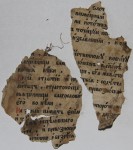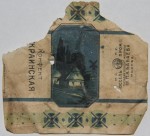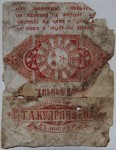 Archaeologists have discovered an archive of 19th and early 20th century Russian history assembled by birds nesting in the attic of the Cathedral of the Assumption in Zvenigorod, a small medieval town 40 miles west of Moscow. Restorers have been working on the church, built in the early 15th century, since 2009, repairing the facade, windows and dismantling 19th century brick archways to return the arches and vaults to their original dimensions. Underneath the brick they found a fragment of a fresco of a seraphim surrounded by saints whose composition suggests it may have been painted by Andrei Rublev, Russia’s greatest medieval artist of icons and frescoes, or an artist from his school.
Archaeologists have discovered an archive of 19th and early 20th century Russian history assembled by birds nesting in the attic of the Cathedral of the Assumption in Zvenigorod, a small medieval town 40 miles west of Moscow. Restorers have been working on the church, built in the early 15th century, since 2009, repairing the facade, windows and dismantling 19th century brick archways to return the arches and vaults to their original dimensions. Underneath the brick they found a fragment of a fresco of a seraphim surrounded by saints whose composition suggests it may have been painted by Andrei Rublev, Russia’s greatest medieval artist of icons and frescoes, or an artist from his school.
 This summer restoration began on the roof of the cathedral. To clear the space before construction, archaeologists surveyed the attic which had a thick layer of debris deposited by the swifts and jackdaws that have been nesting under the roof for centuries. The debris is composed of soil, organic litter, branches and layer upon layer of soft and warm paper fragments collected by the birds to line their nests. Among the fragments are pieces of personal letters, scores of them written in an aristocratic hand that mention Russian foreign minister Count Karl Nesselrode, pieces of printed books, pre-revolutionary official documents drawn up by the military and police, a birth certificate, a college diploma, student notebooks with multiplication tables and Easter hymns. The oldest piece is thought to date to the 1830s when the church roof was last replaced.
This summer restoration began on the roof of the cathedral. To clear the space before construction, archaeologists surveyed the attic which had a thick layer of debris deposited by the swifts and jackdaws that have been nesting under the roof for centuries. The debris is composed of soil, organic litter, branches and layer upon layer of soft and warm paper fragments collected by the birds to line their nests. Among the fragments are pieces of personal letters, scores of them written in an aristocratic hand that mention Russian foreign minister Count Karl Nesselrode, pieces of printed books, pre-revolutionary official documents drawn up by the military and police, a birth certificate, a college diploma, student notebooks with multiplication tables and Easter hymns. The oldest piece is thought to date to the 1830s when the church roof was last replaced.
 One fragment holds historical weight out of proportion to its dimensions. It’s a calendar page from December 6th, 1917, Tsar Nicholas II’s name day, that has a handwritten note on the back quoting a verse by poet Yakov Polonsky about taking comfort in the loss of hope and happiness which in hindsight seems a little premonitory. Nicholas and his family were still alive at the time, but imprisoned in a mansion in Tobolsk. The scrap is a keyhole into the transition of the Old Style Russian dating to the New Style. Russia had used the Julian calendar for centuries, but the Soviets finally switched the country over to the Gregorian system on January 1st, 1918. Both dating systems appear on this calendar page scrap. The big red six is the Julian date, while underneath it in French is the Gregorian date, December 19th, 1917.
One fragment holds historical weight out of proportion to its dimensions. It’s a calendar page from December 6th, 1917, Tsar Nicholas II’s name day, that has a handwritten note on the back quoting a verse by poet Yakov Polonsky about taking comfort in the loss of hope and happiness which in hindsight seems a little premonitory. Nicholas and his family were still alive at the time, but imprisoned in a mansion in Tobolsk. The scrap is a keyhole into the transition of the Old Style Russian dating to the New Style. Russia had used the Julian calendar for centuries, but the Soviets finally switched the country over to the Gregorian system on January 1st, 1918. Both dating systems appear on this calendar page scrap. The big red six is the Julian date, while underneath it in French is the Gregorian date, December 19th, 1917.

 There are also fragments of ration coupons, a bread coupon from December of 1933, and a stamped ration card from August of 1941. Other financial records found in the attic are a contract on the delivery of a cow in 1936, a donation to the monastery of St. Sava Storozhevsky and a loan to a merchant. There’s even a piece of a 1,000 ruble banknote which was worth a great deal of money when it was lost and claimed by the avian archivists.
There are also fragments of ration coupons, a bread coupon from December of 1933, and a stamped ration card from August of 1941. Other financial records found in the attic are a contract on the delivery of a cow in 1936, a donation to the monastery of St. Sava Storozhevsky and a loan to a merchant. There’s even a piece of a 1,000 ruble banknote which was worth a great deal of money when it was lost and claimed by the avian archivists.
Some of the most intact pieces are candy wrappers, probably just because they’re small and didn’t need tearing. They were also probably popular discards on the street, giving the birds a rich source of litter to warm their babies. There are numerous wrappers from pre-revolutionary caramels and candies, plus cigarette packaging of brands from the Petrograd Soviet.



The scraps suffered beak damage — there’s extensive hole punching — but they are still legible, some with great graphics in surprisingly bright color. Zvenigorod Museum archaeologist Alexey Alexeev has uploaded dozens of pictures of the bird archive scraps to this photo album.
Beak marks, eh? I think the birds didn’t quite get the purpose of ration coupons.
I love this blog! Such neat information. Who would have thought wildlife could be responsible for preserving human history!
That is absolutely fascinating.